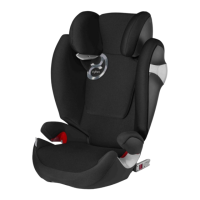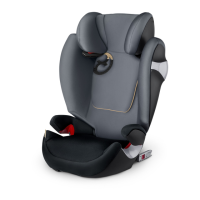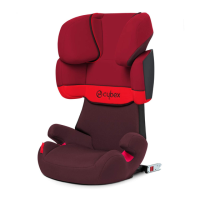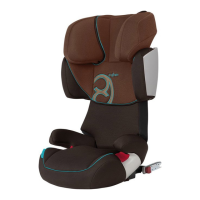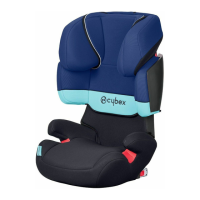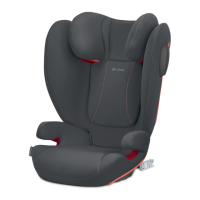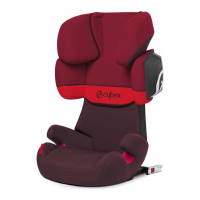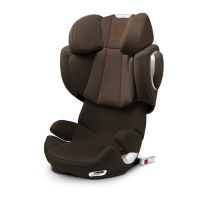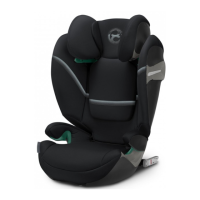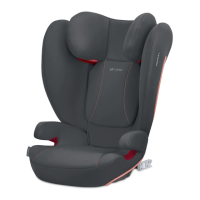DEENIT
19
6. Now feed the diagonal belt (f) through the upper belt guide (g) in the headrest (e)
until it is inside the belt guide.
6. Far passare ora la cintura diagonale (f) attraverso la guida della cintura superiore (g)
nel poggiatesta (e) fino a che si trova nella guida della cintura.
Ensure that the diagonal belt (f) runs between the outside of the shoulder and the
neck of your child. If necessary, adjust the height of the headrest to change the posi-
tion of the belt. The height of the headrest (e) can still be adjusted while in the car.
Accertare che la cintura diagonale (f) scorra tra l'esterno della spalla e il collo del
bambino. Se necessario regolare l'altezza del poggiatesta per cambiare la posizione
della cintura. L'altezza del poggiatesta (e) è regolabile anche in auto.
3. Next, place the lap belt (n) in the lower belt guides (k) of the child car seat.
4. Now pull the diagonal belt (f) firmly to tighten the lap belt (n). The tighter the
belt sits, the better it provides protection from injury. On the side of the belt
buckle (l), the diagonal belt (f) and the lap belt (n) must be inserted together
in the lower belt guide (k).
3. Collocare successivamente la cintura subaddominale (n) nelle guide della cintura
inferiori (k) del seggiolino.
4. Tirare ora saldamente la cintura diagonale (f) per tendere la cintura subaddominale
(n). Maggiormente tesa è la sede della cintura e maggiore è la protezione dalle
lesioni. Cintura diagonale (f) e cintura subaddominale (n) vanno inserite assieme
nella guida della cintura inferiore (k) a lato del fermaglio della cintura (l).
5. The lap belt (n) should have been fed through the lower belt guides (k) on both
sides of the seat cushion (d).
5. La cintura subaddominale (n) dovrebbe passare attraverso le guide della cintura
inferiori (k) su ambo i lati del cuscino di seduta (d).
NOTE! Teach your child from the start to always ensure that the belt is tight and,
if necessary, how to tighten the belt themselves.
NOTA BENE! Insegnare al bambino fin dall'inizio a controllare sempre che la cintura
sia tesa e a tenderla autonomamente se necessario.
To ensure optimum safety for your child, please always check before commencing
travel that...
Per garantire la sicurezza ottimale del bambino, prima di iniziare il viaggio controllare
sempre che...
• the lap belt (n) has been fed through the lower belt guides (k) on both sides of the
seat cushion (d).
• the diagonal belt (f) on the belt buckle side has also been fed through the lower
belt guide (k) of the seat.
• the diagonal belt (f) has been fed through the belt guide (g) marked red in the
shoulder rest (e).
• the diagonal belt (f) is at a recline backwards.
• the entire belt is tightly against your child’s body and is not twisted.
• la cintura subaddominale (n) passi attraverso le guide della cintura inferiori (k) su
ambo i lati del cuscino di seduta (d).
• anche la cintura diagonale (f) sul lato del fermaglio della cintura passi attraverso la
guida inferiore della cintura (k) del seggiolino.
• la cintura diagonale (f) passi attraverso la guida della cintura (g) marcata di rosso
nel poggia-spalla (e).
• la cintura diagonale (f) scorra verso il basso inclinata.
• l'intera cintura poggi tesa contro il corpo del bambino e non sia attorcigliata.
IS YOUR CHILD CORRECTLY SECURED? IL BAMBINO È MESSO IN SICUREZZA CORRETTAMENTE?
WARNING! The vehicle belt buckle (l) must never cross the arm rest. If the
belt system is too long, the child car seat is not suitable for use in this position
in the vehicle. In case of doubt, please consult the manufacturer of your child
car seat.
!
WARNING! The lap belt (n) must run as low as possible on both sides along
your child’s groin to have optimum effect in the event of an accident.
!
ATTENZIONE! Il fermaglio della cintura (l) del veicolo non deve mai
attraversare il bracciolo. Se il sistema di cinture è troppo lungo il seggiolino
non è adatto all‘uso in questa posizione nel veicolo. In caso di dubbio
consultare il costruttore del proprio seggiolino.
!
ATTENZIONE! La cintura subaddominale (n) deve scorrere più bassa
possibile su ambo i lati lungo l‘inguine del bambino per avere l‘effetto ottimale
in caso di incidente.
!
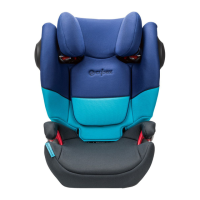
